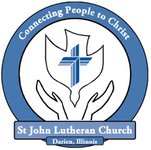Our first church building and an adjacent cemetery were placed on three acres of prairie land that cost $30. Fifteen charter members organized and signed the first constitution under the name German Evangelical Lutheran St. John Congregation on October 17, 1859. For 19 years, the congregation was served by traveling and interim pastors at the intersection of Clarendon Hills Road and 67th Street.
Many of the 254 individuals interred in the cemetery were German Lutheran immigrants. Early settlers of Lace, Cass, and Downers Grove are buried there, including the Andermanns, Kleins, Warkentiens, Lehmans, Veiths, and Mochels. Nine Civil War and two World War I veterans were also laid to rest there. All are remembered today during Darien Historical Society Cemetery Walks and Sons of Union Veterans of the Civil War Ceremonies. The cemetery still contains original, untilled prairie land and is a registered Illinois Natural Heritage Landmark.
In the spring of 1893, work was begun on a new parsonage and the following year a schoolhouse was added behind it. Five years later on February 12, 1899, a special congregational meeting resolved that a new church be built to accommodate the growing membership. Conrad Buschmann donated an acre of land at 75th Street and Cass Avenue in Lace for the second church. The cornerstone was laid on Sunday, May 14, 1899. The new church was dedicated on September 3,1899 with a change in name to St. John Lutheran Church.
Over the course of the next 26 years, St. John Lutheran Church continued to experience growth, organized with other churches, and extended God’s kingdom through Christian education, church planting, and worship in an additional language. In 1906, the congregation became part of the Missouri and Ohio Synod of the Lutheran Church. In October of that same year, a Christian day school was started with 25 students. In 1907, the church underwent a remodeling and refurbishing. In 1909, St. John helped Lutherans in Downers Grove start Immanuel Lutheran Church. In 1912, St. John Lutheran Church was received into membership by the Northern Illinois District—Lutheran Church Missouri Synod. In August of 1915, it was decided to introduce one English service per month. In 1925, St. John, through canvassing, helped organize Bethel Congregation in Westmont.
In 1929, the church constitution was revised and translated into English. Later that year, the church steeple was removed due to damage by wind and lightning. The Luther League youth paid to wire the church for electricity and the Ladies Aid funded the wiring of the parsonage in 1931.
Prompted by the widening of 75th Street, the old parsonage was sold in 1954 with the present one erected in 1958. A decision to build the current educational wing was made in 1964 and the following year on October 10, 1965 it was dedicated. In September 1969, the St. John Lutheran Early Learning Center opened. The school still serves the community today.
Plans began for a new sanctuary to be connected with the educational unit the same year. Our current church was dedicated two years later on September 12, 1971 across the street and down the block from the old sanctuary. Members walked to their new place of worship bearing items from the former sanctuary.
The chancel of the church is Christ-centered in the words of Saint Paul in Colossians 1:16: "For by him all things were created, in heaven and on earth, visible and invisible, whether thrones or dominions or rulers or authorities--all things were created through him and for him." The beautiful stained glass windows were designed by a former pastor of the church, Rev. Edward Runge, and were gifted by the Oestmann and Andermann families. As you face the altar, the large windows on the left represent the creative acts recorded in the Old Testament. The large windows on the right depict the New Testament creative acts. The two smaller windows represent various areas of vocation in which Christ's redeemed followers can serve Him.
On Palm Sunday, 1985, our sanctuary cross was dedicated. The risen Christ upon the cross represents the final great creative act of the resurrection. Having our Risen Lord and Savior front and center is a constant reminder to fix our eyes on Jesus and know that He is the same yesterday, today, and forever. In remembering His many blessings throughout our history, we face the future with confidence, trusting in His guidance, provision, and care.
A new cross was erected to the glory of God on the church campus in May 2016. It was blessed at the conclusion of the worship service on Mother’s Day. Rev. Rodney Serbus, Senior Pastor, noted that “this cross will point people to Christ for the first time and for a life time.”
On September 17, 2016, St. John Lutheran Church was recognized by the Illinois Historical Society at the Sesquicentennial Houses of Worship Celebration in Peoria, IL at the First United Presbyterian Church of Peoria. The ceremony honored churches in Illinois that were 150 years or older. Thirty-seven churches were recognized at the event and joined more than 175 other congregations previously honored. Rev. David Bottorff, Associate Pastor, accepted a Certificate of Recognition on behalf of St. John Lutheran Church.
Parish churches played an important role in the community back in the 1800s. They provided a site for social interaction in addition to a place for worship. Churches were a gathering place for community members to feel a sense of togetherness regardless of age or socioeconomic level. It was a place to connect others to Christ and with each other. St. John Lutheran Church continues that mission 160 years later.
While its location, sanctuaries, and membership have changed over the years, the congregation remains firm in its vision to connect others to God through Word and Sacrament, to connect people within the church family, and to connect with the community through service and evangelism.
The church’s doors are open each week to members and guests for worship services, Sunday School, and small group Bible studies. By sponsoring programs, hosting special events, and partnering with local organizations, the church offers support to area families and the community. Increasingly, St. John Lutheran Church has recognized the importance of leaving the building to perform ministry and mission.
The church looks forward to continuing its proclamation of the Gospel and its service to God and the community in the years ahead.

